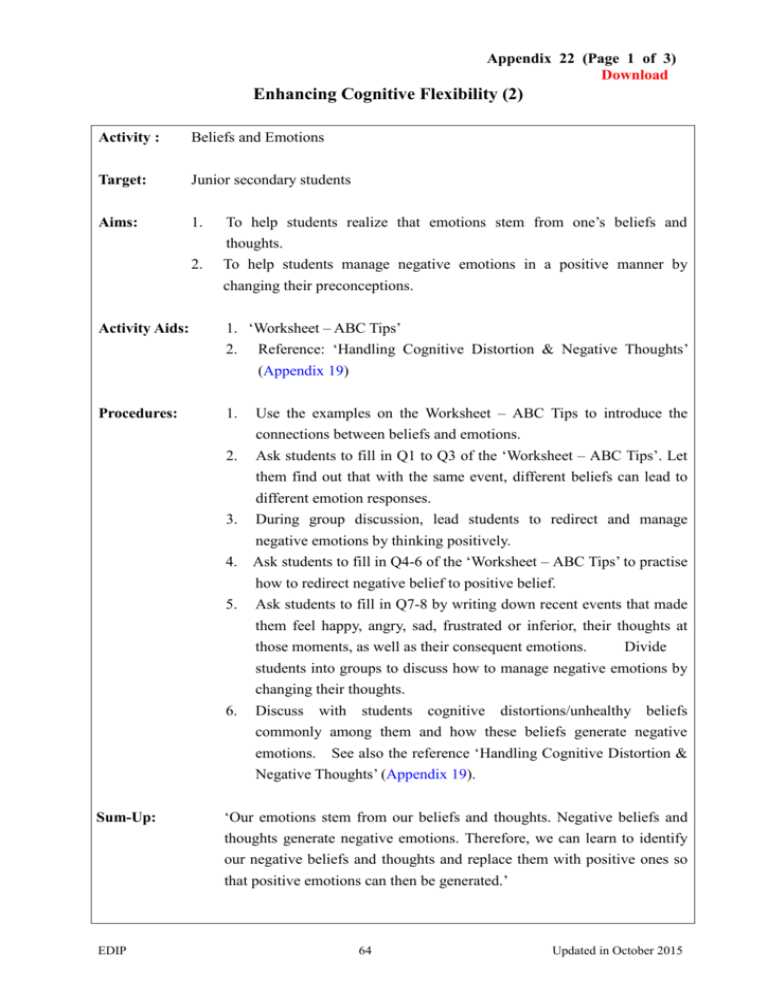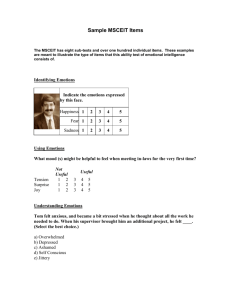Early Detection & Intervention of Student Suicide (EDISS)
advertisement

Appendix 22 (Page 1 of 3) Download Enhancing Cognitive Flexibility (2) Activity : Beliefs and Emotions Target: Junior secondary students Aims: 1. 2. To help students realize that emotions stem from one’s beliefs and thoughts. To help students manage negative emotions in a positive manner by changing their preconceptions. Activity Aids: 1. ‘Worksheet – ABC Tips’ 2. Reference: ‘Handling Cognitive Distortion & Negative Thoughts’ (Appendix 19) Procedures: 1. 2. 3. 4. 5. 6. Use the examples on the Worksheet – ABC Tips to introduce the connections between beliefs and emotions. Ask students to fill in Q1 to Q3 of the ‘Worksheet – ABC Tips’. Let them find out that with the same event, different beliefs can lead to different emotion responses. During group discussion, lead students to redirect and manage negative emotions by thinking positively. Ask students to fill in Q4-6 of the ‘Worksheet – ABC Tips’ to practise how to redirect negative belief to positive belief. Ask students to fill in Q7-8 by writing down recent events that made them feel happy, angry, sad, frustrated or inferior, their thoughts at those moments, as well as their consequent emotions. Divide students into groups to discuss how to manage negative emotions by changing their thoughts. Discuss with students cognitive distortions/unhealthy beliefs commonly among them and how these beliefs generate negative emotions. See also the reference ‘Handling Cognitive Distortion & Negative Thoughts’ (Appendix 19). Sum-Up: EDIP ‘Our emotions stem from our beliefs and thoughts. Negative beliefs and thoughts generate negative emotions. Therefore, we can learn to identify our negative beliefs and thoughts and replace them with positive ones so that positive emotions can then be generated.’ 64 Updated in October 2015 Appendix 22 (Page 2 of 3) Worksheet – ABC Tips Antecedent Belief i) She disturbs me deliberately. (Example 1) ii) She knows that I am feeling My younger sister pushes low. So she wants to give me once. me some fun. i) He picks on me. (Example 2) My classmate criticises ii) He just wants to give me me. some advice. 1. My friend refuses to help me. 2. My class scolds me. 3. I Happy Angry Grateful __________________ ii) He has his own difficulties. __________________ i) He has a bias against me. __________________ ii) He thinks highly of me and has expectations on me. __________________ i) No matter how hard I try, I am doomed to failure. __________________ ii) This is what I predicted because I did not work hard enough. __________________ i) He always humiliates me in front of others. __________________ ii) ______________________ Worried about him i) ______________________ Unhappy ii) ______________________ Feel loved and cared for in 4. My father vents his anger on me in front of others. 5. My teacher says that I write too slowly. EDIP Unhappy i) He fails me. He does not treat me as his friend. teacher did badly dictation. Consequent emotion 65 Updated in October 2015 Appendix 22 (Page 3 of 3) 6. My classmates laugh at me. i) ______________________ ii) ______________________ Feel rejected and miserable Feel easy 7. 8. EDIP 66 Updated in October 2015







